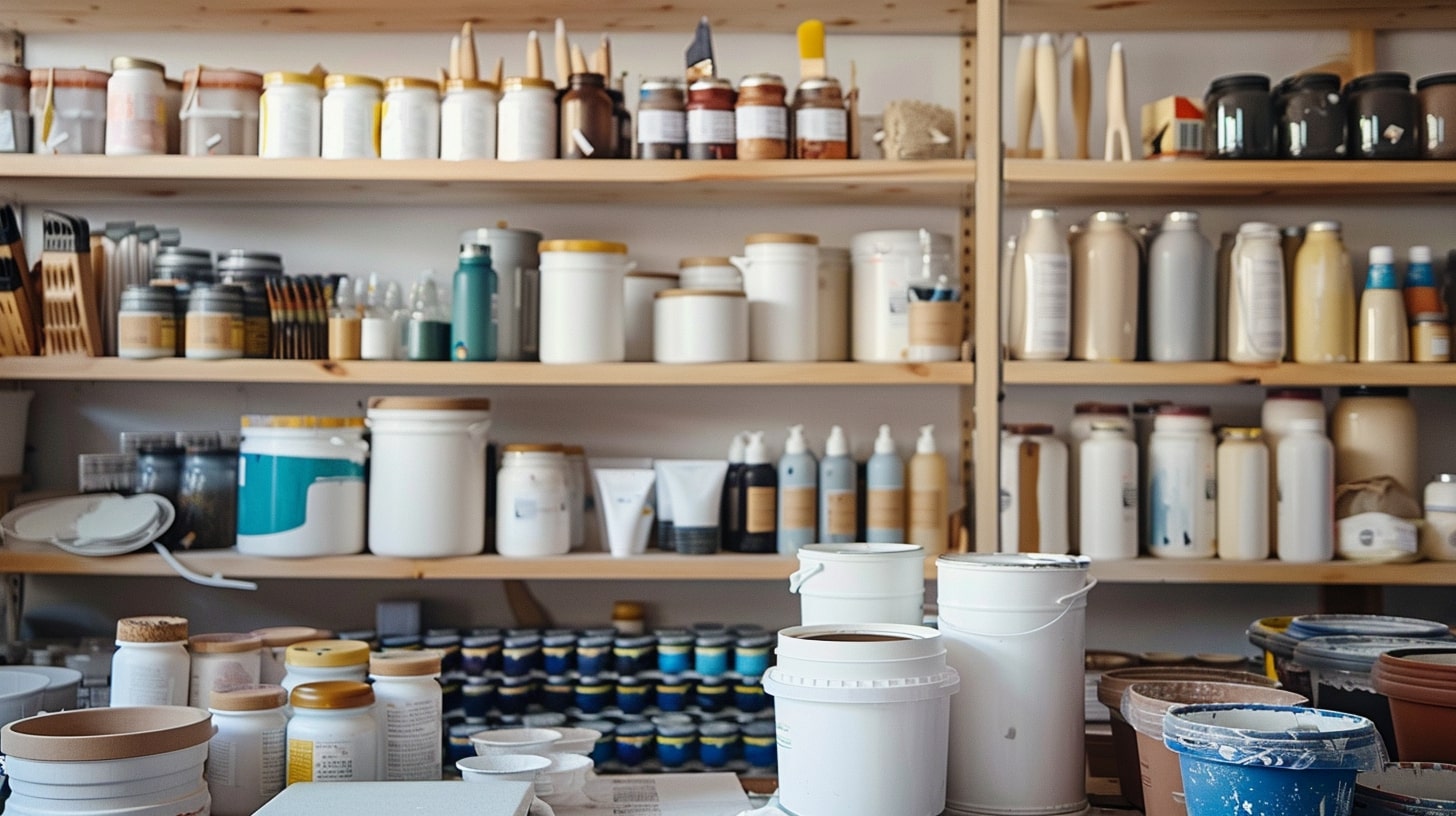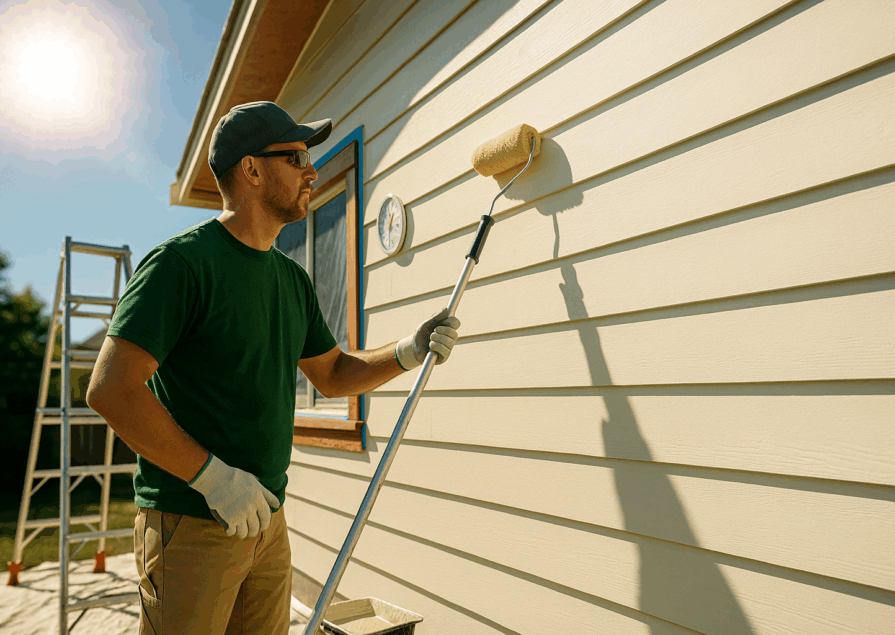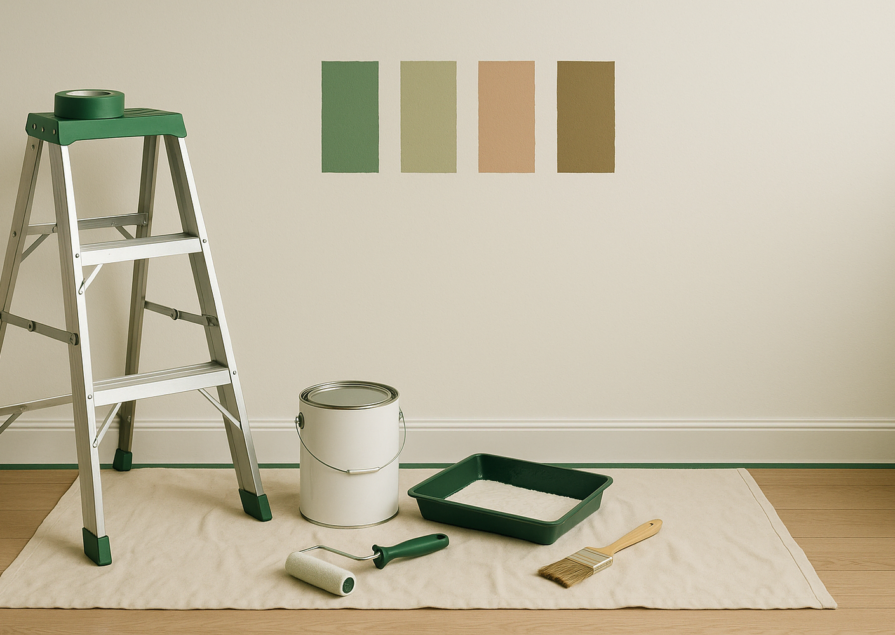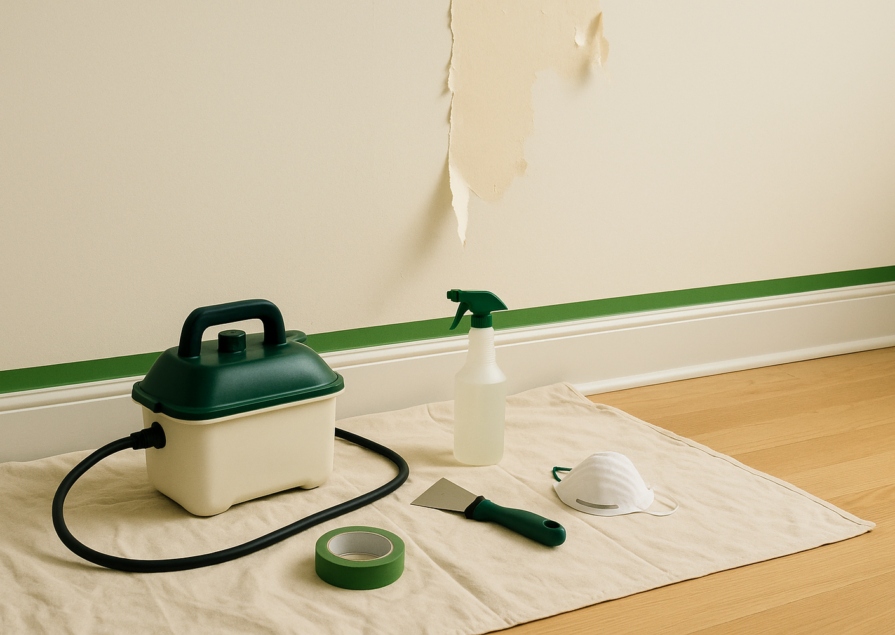Storing your painting supplies properly is crucial to maintaining their quality and extending their lifespan. Whether you’re a professional painter or a DIY enthusiast, knowing how to store brushes, rollers, paints, and other supplies can save you time and money in the long run. Improper storage can lead to damaged bristles, hardened paint, and a cluttered workspace, making your next painting project more frustrating than it needs to be. This guide will walk you through the best practices for cleaning, organizing, and storing your painting supplies to keep them in top-notch condition and ready for use whenever you need them.
Preparing Painting Supplies for Storage
Proper preparation is key to storing your painting supplies effectively. This involves thoroughly cleaning your tools and ensuring they are dry before putting them away. Let’s dive into the specifics of cleaning different types of painting supplies.
Cleaning Brushes and Rollers

- Rinse Immediately: As soon as you finish painting, rinse your brushes and rollers with warm water to remove excess paint.
- Use Soap: Apply a small amount of mild soap or a brush cleaner to the bristles or roller cover. Gently work it using your fingers or a brush comb.
- Rinse Thoroughly: Rinse again under warm water until the water runs clear and no paint remains.
- Dry Completely: Shake off excess water and lay the brushes and rollers flat on a towel to dry. Avoid standing brushes upright while wet, as this can cause water to seep into the ferrule and loosen the bristles.
Fun Fact: Did you know that properly cleaned and stored brushes can last for years? Investing a little time in cleaning can save you from frequently buying new brushes.
Recommended Cleaning Products
Using the right cleaning products can make a significant difference. Here are some recommended products:
- Mild Dish Soap: Effective for most water-based paints.
- Brush Cleaner: Specially formulated to break down oil-based paints.
- Brush Comb: Helps remove paint trapped in the bristles and maintain their shape.
Key Takeaway: Always clean your brushes and rollers immediately after use to prevent paint from drying and hardening.
Cleaning Palettes and Paint Containers
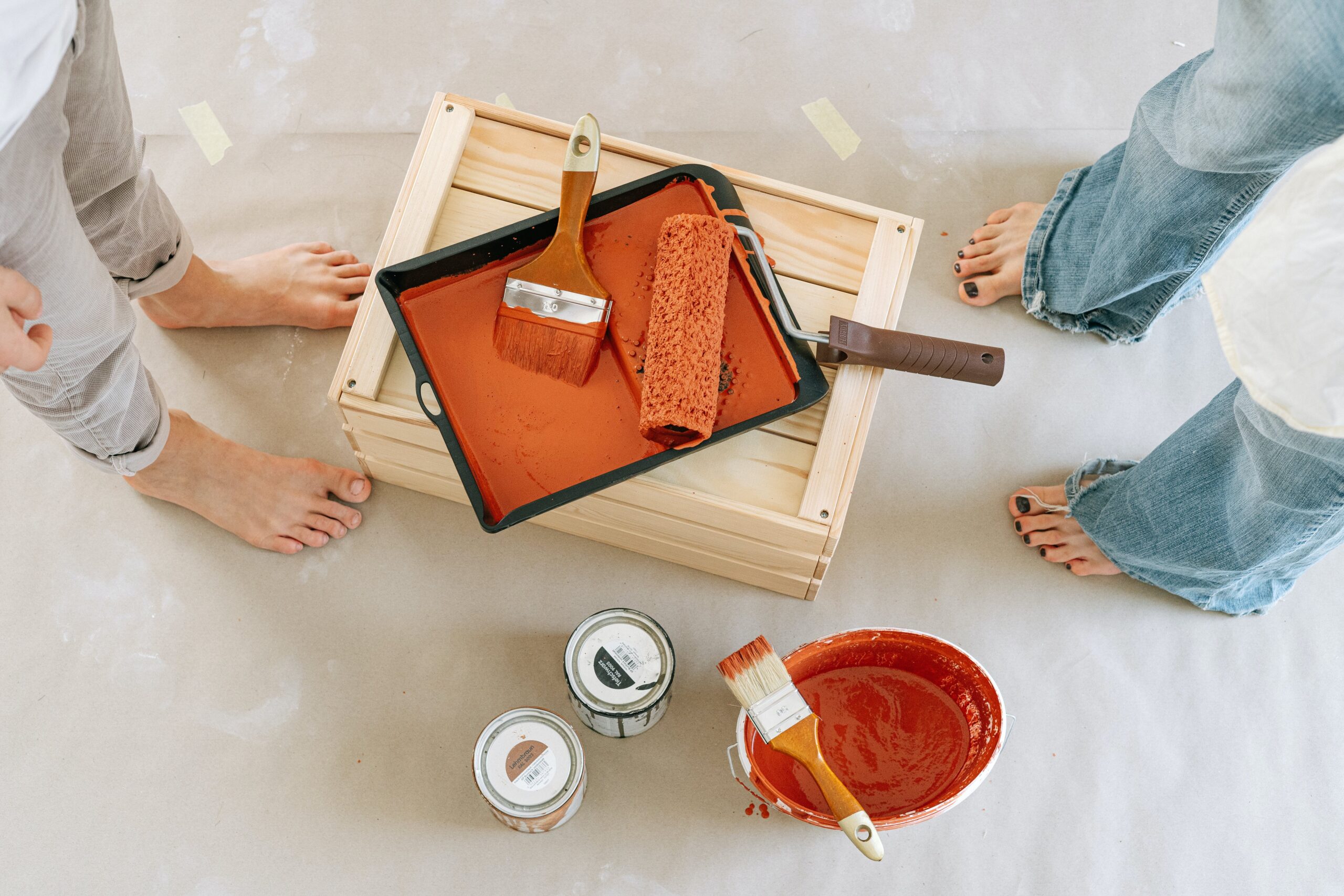
Cleaning Techniques for Different Types of Palettes
Different palettes require different cleaning methods:
- Plastic Palettes: Wipe off excess paint with a paper towel, then wash with warm soapy water.
- Glass Palettes: Scrape off dried paint with a razor blade, then clean with glass cleaner.
- Wooden Palettes: Scrape off excess paint, then rub with linseed oil to keep the wood from drying out.
Maintaining Paint Containers
Properly maintaining your paint containers can prevent contamination and extend the life of your paint:
- Seal Tightly: Ensure lids are tightly sealed to prevent air from entering and drying out the paint.
- Label Clearly: Mark the paint color, brand, and date of purchase on the container for easy identification.
- Store Upside Down: For cans, store them upside down to create a tight seal and reduce air exposure.
Pro Tip: Always pour paint into a separate container for use, rather than dipping directly from the main container, to avoid contamination.
Storing Brushes
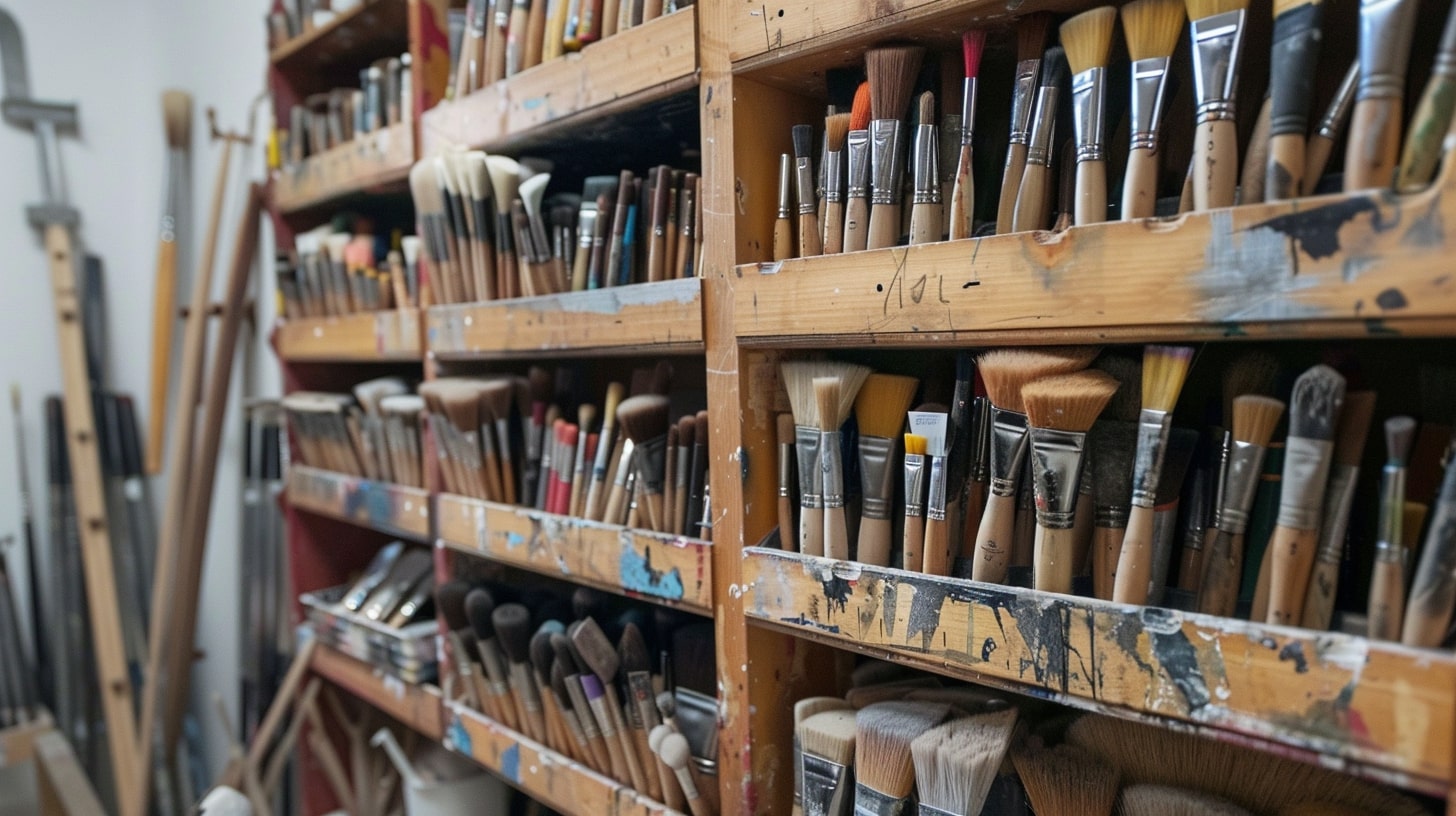
Choosing the Right Storage Container
Selecting the appropriate storage container is essential to keeping your brushes safe and organized. Here are some options:
- Brush Holders: These are specially designed containers that hold brushes upright and prevent bristle damage.
- Tubes and Cases: Ideal for transporting brushes without bending the bristles.
- DIY Solutions: Repurpose jars, vases, or even PVC pipes to create custom brush holders.
Storing Brushes Vertically
Storing brushes vertically is highly recommended to maintain their shape and integrity. Here’s why:
- Prevents Bending: Vertical storage keeps bristles straight and prevents them from becoming misshapen.
- Easy Access: Brushes are easily accessible and visible, making it simple to find the one you need.
- Air Circulation: Allows for proper air circulation around the bristles, preventing mold growth.
DIY Tip: Use a piece of foam or a sponge with holes cut out to hold brushes upright in a jar or container.
Protecting Brush Bristles
Protecting the bristles is crucial to extending the life of your brushes. Follow these tips:
- Use Brush Guards: Slip-on guards keep bristles in shape and prevent them from bending.
- Store Horizontally: If vertical storage isn’t an option, lay brushes flat to avoid bristle damage.
- Avoid Crushing: Never store brushes under heavy objects that could crush the bristles.
Fun Fact: High-quality brushes, when stored properly, can last for many years, making them a worthy investment for any painter.
Storing Rollers

Wrapping Rollers
Wrapping rollers properly helps keep them in good condition between uses. Here’s how:
- Use Plastic Wrap: Wrap the roller tightly in plastic wrap or a plastic bag to keep it moist.
- Seal with Tape: Secure the plastic wrap with tape to ensure no air gets in.
- Label: Mark the roller with the type of paint used and the date for easy identification.
Using Roller Covers
Roller covers are designed to protect rollers during storage. Here’s why you should use them:
- Prevent Drying: Covers keep rollers moist and ready for immediate use.
- Easy Cleanup: Reduce the need for thorough cleaning between uses.
- Cost-Effective: Extend the life of your rollers, saving money in the long run.
Pro Tip: Invest in reusable roller covers that can be cleaned and used multiple times.
By following these steps, you’ll ensure that your painting supplies remain in excellent condition, ready for your next project. Proper storage not only saves you money but also makes your painting experience smoother and more enjoyable.
Storing Paints

Sealing Paint Cans
Sealing paint cans correctly is crucial to prevent the paint from drying out and becoming unusable. Here are some techniques to ensure a tight seal:
- Clean the Rim: Before sealing, wipe the rim of the can with a damp cloth to remove any paint residue. This ensures a tight seal when you replace the lid.
- Use Plastic Wrap: Place a piece of plastic wrap over the can before replacing the lid. This adds an extra layer of protection against air.
- Hammer Gently: Use a rubber mallet or a hammer with a cloth to gently tap the lid back onto the can. Avoid pounding too hard to prevent deforming the lid.
Pro Tip: For paint cans that don’t seal well, transfer the paint to airtight plastic containers to ensure longevity.
Organizing Paint Cans
A well-organized paint storage area makes it easier to find the right paint when you need it. Here are some tips for organizing your paint cans:
- Label Clearly: Use labels to mark the paint color, brand, and date of purchase on each can. This helps in quickly identifying the right paint.
- Group by Type: Organize paints by type (e.g., latex, oil-based) and by color family. This makes it easier to find what you need.
- Use Shelves: Store paint cans on sturdy shelves. Keep heavier cans on lower shelves and lighter cans on higher ones.
Storing Spray Paint

- Cool, Dry Place: Store spray paint in a cool, dry place away from direct sunlight and heat sources. Extreme temperatures can cause the paint to degrade.
- Shake Before Storing: Shake the can well before storing to prevent the nozzle from clogging. This helps distribute the propellant and paint evenly.
- Store Upright: Keep spray paint cans upright to prevent leakage and ensure the nozzle stays clear.
Fun Fact: Spray paint cans can last for several years if stored correctly, making them a versatile tool for various projects.
Storing Palettes and Mixing Trays
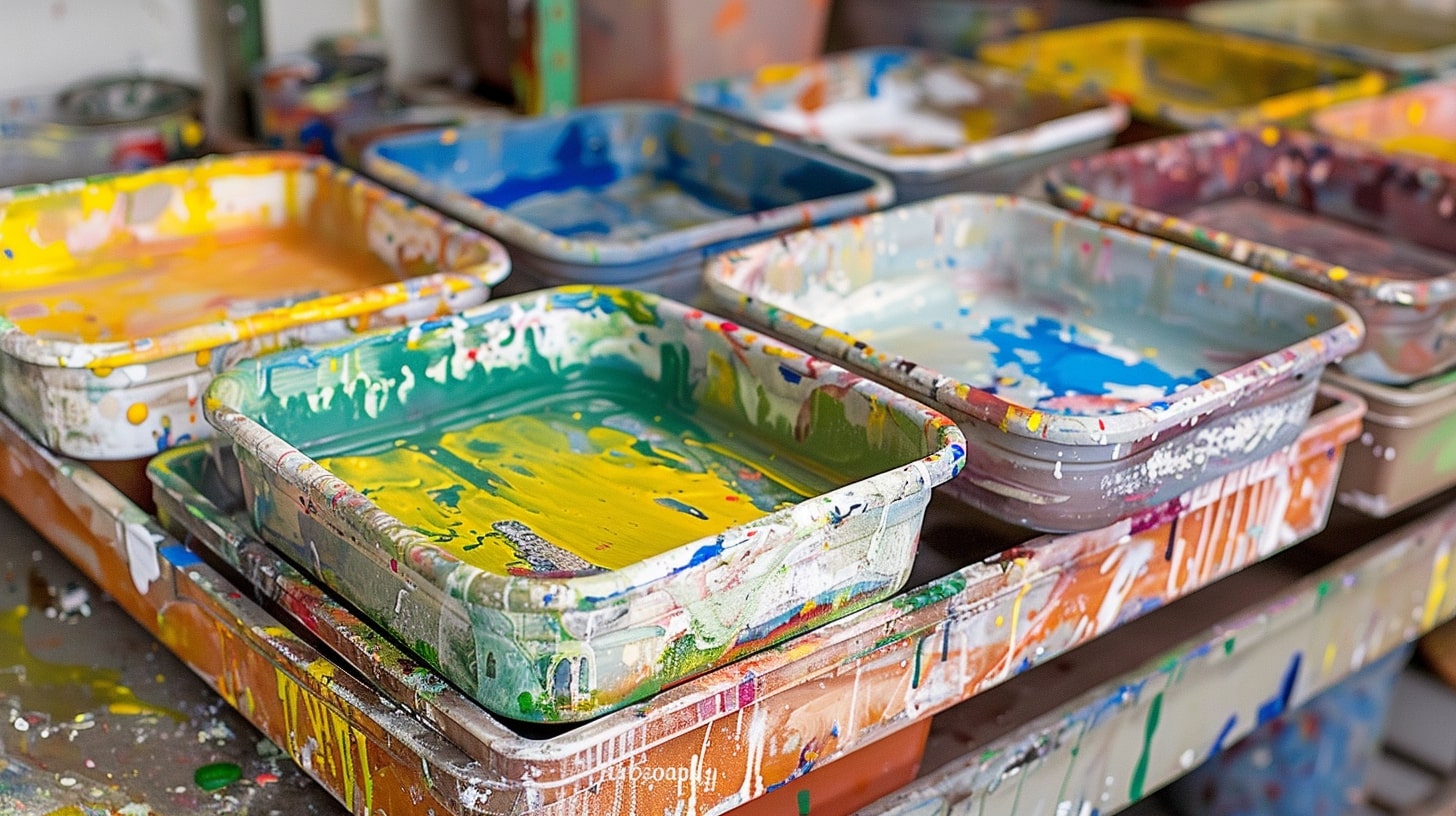
Cleaning and Drying
Cleaning your palettes and mixing trays after each use is crucial to maintaining their usability. Here’s how to do it effectively:
- Scrape Off Excess Paint: Use a palette knife or scraper to remove any remaining paint from the surface.
- Wash with Soap and Water: For plastic and glass palettes, wash with warm soapy water. For wooden palettes, use a mild soap and water, then dry immediately.
- Dry Thoroughly: Ensure the palette or tray is completely dry before storing to prevent mold and mildew.
Space-Saving Storage Ideas
Efficient storage of palettes and mixing trays helps keep your workspace organized. Here are some space-saving ideas:
- Vertical Racks: Use vertical racks or file organizers to store palettes and trays upright. This saves space and keeps them easily accessible.
- Stackable Trays: Invest in stackable mixing trays that can be nested together when not in use.
- Wall-Mounted Holders: Install wall-mounted holders or hooks to keep palettes off your work surface.
DIY Tip: Repurpose a dish drying rack to store palettes and mixing trays. It’s an affordable and practical solution.
Storing Miscellaneous Supplies
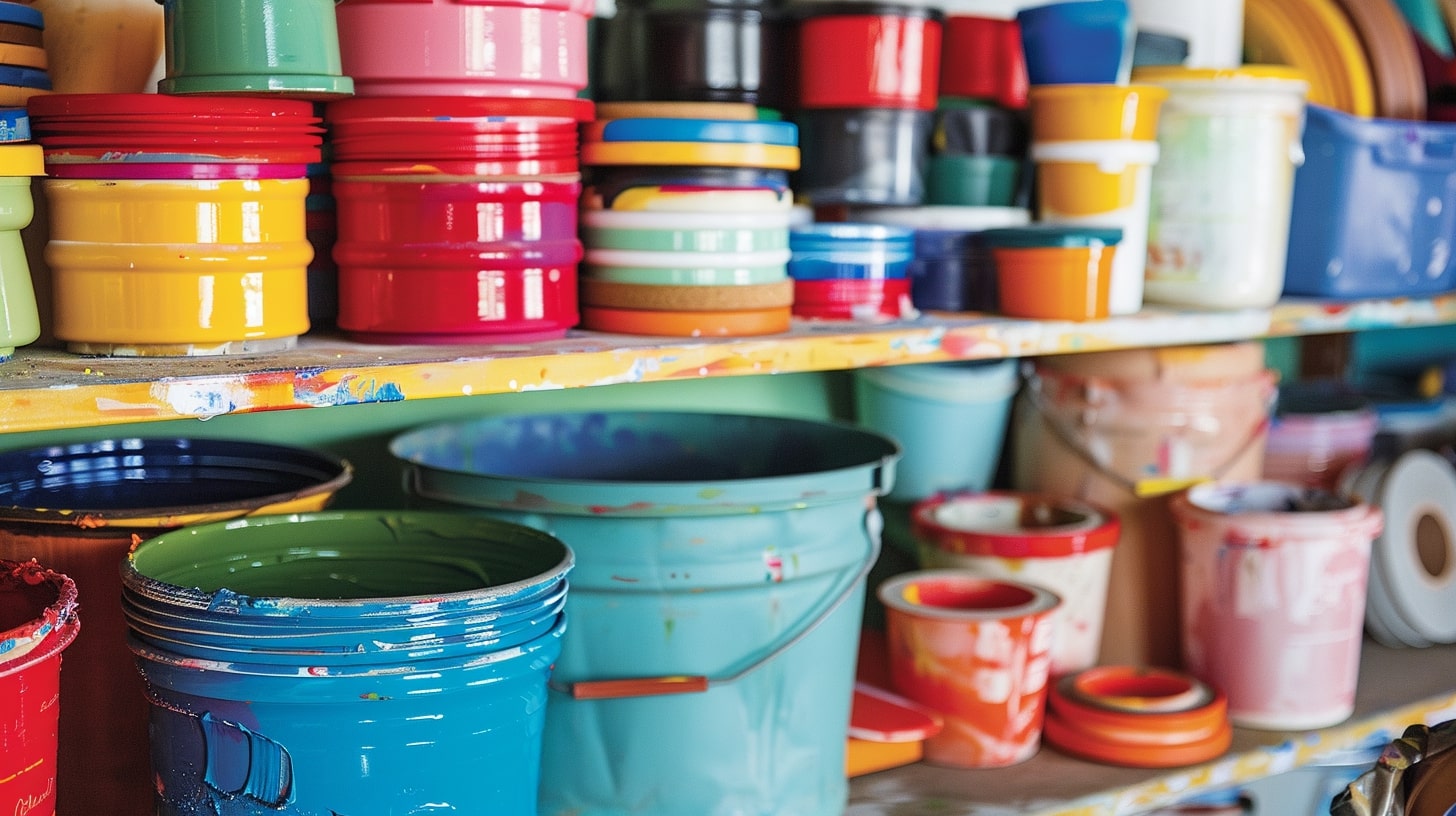
Storing Tape and Drop Cloths
Tape and drop cloths are essential for any painting project. Here’s how to store them properly:
- Keep Tape in a Cool Place: Store painter’s tape in a cool, dry place to maintain its adhesive properties. Avoid storing in direct sunlight or humid areas.
- Fold Drop Cloths Neatly: After use, shake off any debris and fold drop cloths neatly. Store them in a plastic bin or on a shelf to keep them clean and ready for the next project.
Storing Mixing Sticks and Rags
Mixing sticks and rags are small but essential tools that can be easily overlooked. Here’s how to store them:
- Bundle Mixing Sticks: Keep mixing sticks bundled together with a rubber band or store them in a jar or container.
- Wash and Dry Rags: After use, wash rags thoroughly and let them dry completely before storing. Store clean rags in a bin or drawer.
Pro Tip: Use a small plastic bin to keep mixing sticks and rags organized and easily accessible.
By following these steps, you’ll ensure that all your painting supplies are stored properly and ready for use whenever you need them. Proper storage not only keeps your supplies in good condition but also makes your painting projects more efficient and enjoyable.
Creating a Dedicated Storage Space
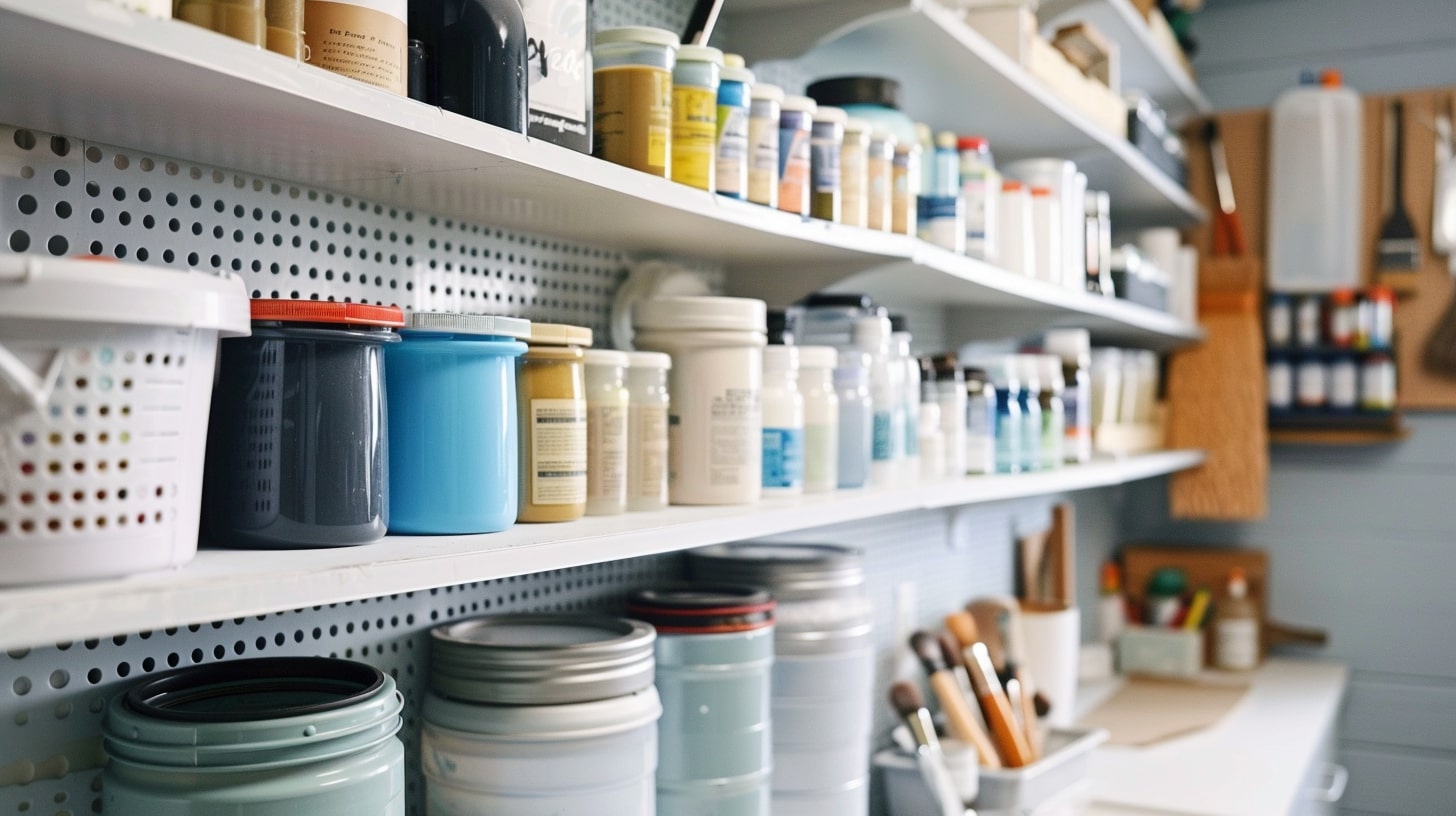
Organizing Your Workspace
A well-organized workspace allows you to find your supplies quickly and easily, reducing frustration and time wasted searching for tools. Here are some layout ideas:
- Designate Zones: Create specific zones for different types of supplies, such as brushes, paints, and cleaning tools. This makes it easy to locate what you need.
- Use Containers: Utilize bins, baskets, and containers to group similar items together. Label each container for easy identification.
- Clear Counter Space: Keep your main work area clear of clutter. Store frequently used items within arm’s reach, but keep the rest neatly tucked away.
Fun Fact: A tidy workspace can boost your productivity and creativity by reducing distractions and making it easier to focus on your project.
Utilizing Vertical Space
Vertical space is often underutilized, but it can be incredibly useful for storing painting supplies. Here are some ideas for making the most of your vertical space:
- Install Shelves: Add shelves to your walls to store paint cans, brushes, and other supplies. Adjustable shelves are a great option for accommodating different sizes of items.
- Use Pegboards: Pegboards are perfect for hanging tools and supplies. Customize the layout with hooks, baskets, and shelves to suit your needs.
- Hanging Storage: Use wall-mounted racks and hooks to hang brushes, rollers, and other tools. This keeps them off your work surface and within easy reach.
DIY Tip: Repurpose old shelves or cabinets to create additional storage space in your workspace.
Maintenance Tips
Regular maintenance of your painting supplies and storage area ensures everything stays in good condition and ready for use. Here are some tips to help you keep everything in top shape.
Regular Inventory Checks
Keeping track of your supplies helps you stay organized and ensures you never run out of essential items. Here’s how to conduct regular inventory checks:
- Create an Inventory List: List all your painting supplies, including brushes, paints, rollers, and other tools. Update the list as you use and purchase items.
- Set a Schedule: Conduct inventory checks regularly, such as once a month or before starting a new project. This helps you stay on top of your supplies.
- Dispose of Expired Items: Check expiration dates on paint cans and other materials. Dispose of any items that are no longer usable.
Pro Tip: Use a digital inventory app to keep track of your supplies and set reminders for inventory checks.
Keeping Storage Area Clean
A clean storage area prevents dust and dirt from contaminating your supplies and helps you maintain an organized workspace. Here are some tips for keeping your storage area clean:
- Dust Regularly: Dust shelves, containers, and tools regularly to prevent buildup. Use a microfiber cloth or duster for best results.
- Clean Spills Immediately: Clean up any paint spills or leaks as soon as they occur to prevent staining and damage to your storage area.
- Organize Periodically: Periodically reorganize your storage area to ensure everything is in its proper place and easily accessible.
Conclusion
Properly storing your painting supplies is essential for maintaining their quality and ensuring they are ready for use when you need them. By following the tips and guidelines outlined in this article, you can create an organized and efficient storage system that saves you time and money. Remember to clean your tools thoroughly, use appropriate storage containers, and regularly maintain your storage area. With a little effort, you can keep your painting supplies in excellent condition and enjoy a smooth and enjoyable painting experience.
FAQs
- How long can paint be stored before it goes bad?
- Paint can last for several years if stored properly. Latex paint typically lasts 2-10 years, while oil-based paint can last up to 15 years. Ensure cans are sealed tightly and stored in a cool, dry place.
- Can I store painting supplies in a garage or basement?
- Yes, you can store painting supplies in a garage or basement as long as the area is cool, dry, and free from extreme temperature fluctuations. Avoid areas with high humidity or direct sunlight.
- What’s the best way to store oil-based paints?
- Store oil-based paints in their original containers, sealed tightly. Keep them in a cool, dry place away from heat sources and direct sunlight. Label containers clearly and store them upright.
- How do I prevent my brushes from becoming stiff?
- Clean brushes thoroughly after each use and store them in a way that allows bristles to maintain their shape. Use brush guards and avoid storing them bristle-side down.
- Are there any specific products recommended for paint storage?
- Yes, there are several products available to help with paint storage, including airtight plastic containers, paint can sealers, and reusable roller covers. Investing in these products can help extend the life of your paint and tools.
